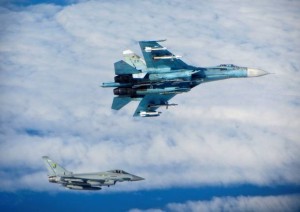05/02/2016: On April 27th, 2016, F-22s deployed to the Baltics.
According to an April 29, 2016 article in RFE/RL:
The U.S. Air Force landed two of its most advanced jets in Lithuania for the first time on April 27 in a show of support for a region worried by Russian aggression in Ukraine.
NATO’s Baltic members have been riled by acts by Russian warplanes in recent weeks, including one making “simulated attack passes” near a U.S. warship and another passing within 50 feet of a U.S. reconnaissance plane.
The F-22 fighter jets, which previously visited Poland, Estonia, and Romania, were greeted by Lithuanian President Dalia Grybauskaite.
“Without singling out any neighbor, I would like to say that no one has any right to poke their noses into here,” she said. “This is a demonstration that the United States is honoring its commitments and is ready to protect our region with all the most modern measures.”
F-22s are almost impossible to detect on radar and are so advanced that the U.S. Congress has banned Lockheed Martin from selling them abroad.
Russian Foreign Minister Sergei Lavrov in a Swedish newspaper interview published on April 28 charged that Lithuania is the “most Russophobic country in the Baltic region.”
http://www.rferl.org/content/us-f-22-fighter-jets-land-lithuania-show-of-force-aimed-at-russia/27705665.html
Credit:100th Air Refueling Wing Public Affairs:4/27/16
According to an April 27, 2016 story by USAFE:
4/27/2016 – ŠIAULIAI AIR BASE, Lithuania — Two F-22 Raptors and one KC-135 Stratotanker arrived at Šiauliai Air Base Air Base, Lithuania, today. The F-22s and approximately 20 supporting Airmen are from the 95th Fighter Squadron, Tyndall Air Force Base, Florida. The KC-135 is from the 100th Air Refuel Wing, RAF Mildenhall, England.
The aircraft and Airmen were welcomed by Lithuanian President Dalia Grybauskaitė, and other distinguished visitors from the Lithuanian government and military.
“This is a demonstration that the United States is honoring its commitments and is ready to protect our region with all the most modern measures,” said the president in a press conference. The two aircraft and Airmen are currently part of the largest F-22 deployment to Europe.
The deployment is partially funded by the European Reassurance Initiative, which provides support to bolster the security of our NATO allies and partners in Europe while demonstrating the U.S. commitment to regional and global security.
“Today’s demonstration is part the collective defense and security of our NATO Allies, a commitment that is underscored in President Obama’s $3.4 billion request for the European Reassurance Initiative,” added the U.S. Ambassador to Lithuania Deborah A. McCarthy.
The F-22s will remain at Šiauliai AB for a brief period of time before returning to RAF Lakenheath, England, to continue their training deployment until May 2016. Similarly, two F-22s, support Airmen and aircraft were deployed for a short amount of time to Mihail Kogalniceanu AB, Romania, just two days prior to their arrival at Šiauliai AB.
“Thanks to our gracious Allies, we are able to fly over 200 F-22 integration sorties in Europe,” Lehoski said. “The integration training we are completing during this trip, and our allies’ ability to host 5th generation aircraft, are critical to future successes.”
Through maximized training opportunities in Europe and by demonstrating the U.S. commitment to NATO, the deployment also serves to deter actions that destabilize regional security.
“The deployment to Europe, showcases our ability to provide air dominance … anytime, anywhere,” said Lehoski. “Because of our talented and dedicated Airmen and allies, we have demonstrated our ability to forward deploy F-22s throughout Europe, integrate with our allies, and put decisive airpower in the skies.”
http://www.usafe.af.mil/news/story.asp?id=123473013


